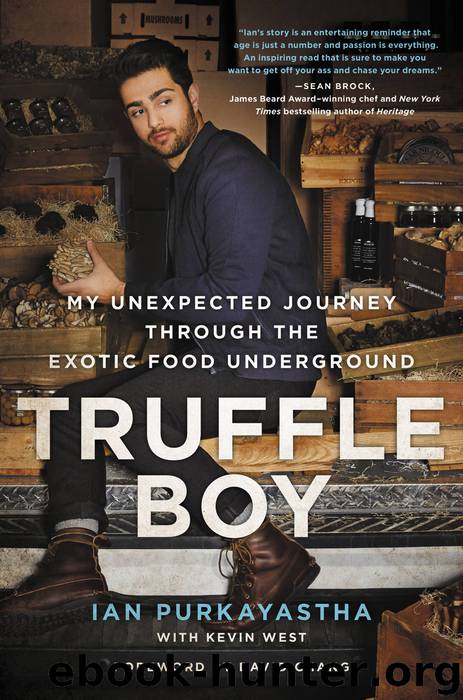Truffle Boy by Author

Author:Author
Language: eng
Format: epub
Published: 2019-02-07T16:00:00+00:00
The hell of school had one escape: weekends at my grandparents’ house in Huntsville, an hour north of Houston. They lived on five acres adjacent the Goree Unit of the Texas Department of Criminal Justice, a death-row penitentiary that for years held the world-famous Texas Prison Rodeo. Hundreds of horses still grazed the surrounding pastures making my grandparents’ house a rural heaven to me. For my entire life I’ve associated my mother’s family with the outdoors and country living.
According to my grandmother, Nona Pebworth, the family genealogist, our ancestor Robert Pebworth came to America from England as an indentured servant in the eighteenth century. He might have been born in the small village of Pebworth, in Worcestershire, where legend has it William Shakespeare once passed out drunk beneath a crabapple tree. Robert pretended to be illiterate so that when he arrived in America he could forge his own bill of passage to secure his freedom. My aunt Alison, mom’s sister, has an original handbill for “the outlaw Robert Pebworth.”
Later Pebworths moved west, intermarrying with Choctaw Indians along the way. The family jokingly calls me and Larkin “double Indians” for our mixed-blood background.
My great-grandfather was one-half Choctaw and born in Kinta, Oklahoma, on Choctaw Nation lands established by the 1830 Treaty of Dancing Rabbit Creek. He pretended to be only one-quarter native to avoid “reeducation” programs but couldn’t escape Jones Academy, a strict military-style school founded in 1891 to make Indian boys into farmers. Native language and dress were forbidden. He fought in World War I, suffering wounds, and later went to work for the Osage tribe on their reservation in northeast Oklahoma, the setting for August: Osage County. Unlike most tribes, the Osage had retained mineral rights in their treaties with the U.S. government. Their land sat on an ocean of oil, and when the wells struck, the tribe became wildly rich. Royalty payments from oil companies provided so much tribal income that in the 1920s the local Pierce-Arrow and Cadillac dealerships were the busiest in the country. My great-grandfather called himself “the wrong kind of Indian” because as a Choctaw he didn’t share the Osage wealth. Instead, he worked in their oilfields for a modest salary.
Grandpa, unlike my great-grandfather, never tried to disguise his Native American heritage but instead used it in his art and taught his children about their roots. My aunt Alison in San Francisco, also an artist, found inspiration in Native American history and culture for her exhibition Beautiful Possibility, a collection of hand-drawn maps and paintings that combined the aesthetics of nineteenth-century illustration with carnival sideshow signage.
After Grandpa returned from World War II, he met my grandmother, Nona DeShazo, at the University of Oklahoma. Her ancestors were Dutch immigrants who arrived in America in 1679 and settled in what is now Bushwick, Brooklyn. My mom has a will written by one of her distant grandmothers who bequeathed her daughter land at the corner of Pearl Street in Manhattan, named after the East River’s oyster beds. The site, near present-day Wall Street, now unfortunately holds a liquor store.
Download
This site does not store any files on its server. We only index and link to content provided by other sites. Please contact the content providers to delete copyright contents if any and email us, we'll remove relevant links or contents immediately.
The 5 Love Languages: The Secret to Love That Lasts by Gary Chapman(9588)
The Space Between by Michelle L. Teichman(6859)
Assassin’s Fate by Robin Hobb(6128)
Wiseguy by Nicholas Pileggi(5671)
Everything Happens for a Reason by Kate Bowler(4678)
Gerald's Game by Stephen King(4582)
Pillow Thoughts by Courtney Peppernell(4208)
A Simplified Life by Emily Ley(4099)
The Power of Positive Thinking by Norman Vincent Peale(4003)
Harry Potter and the Prisoner of Azkaban (Book 3) by J. K. Rowling(3304)
Resisting Happiness by Matthew Kelly(3301)
Being Aware of Being Aware by Rupert Spira(3229)
Girl, Wash Your Face by Rachel Hollis(3210)
The Code Book by Simon Singh(3074)
The Secret Power of Speaking God's Word by Joyce Meyer(2972)
Real Sex by Lauren F. Winner(2967)
More Language of Letting Go: 366 New Daily Meditations by Melody Beattie(2966)
Name Book, The: Over 10,000 Names--Their Meanings, Origins, and Spiritual Significance by Astoria Dorothy(2939)
The Holy Spirit by Billy Graham(2892)
